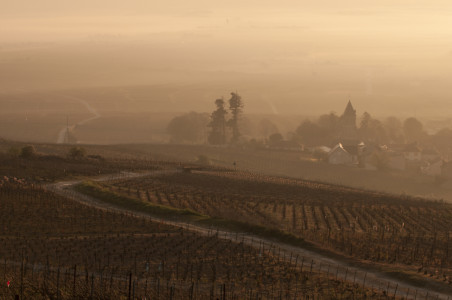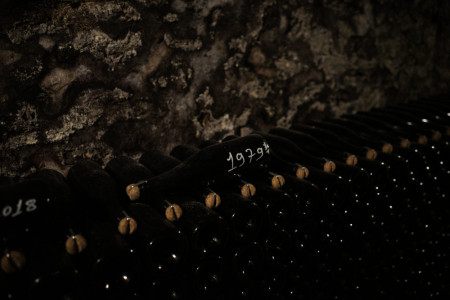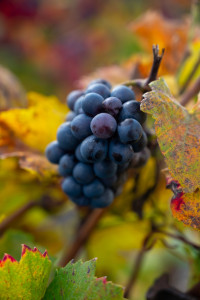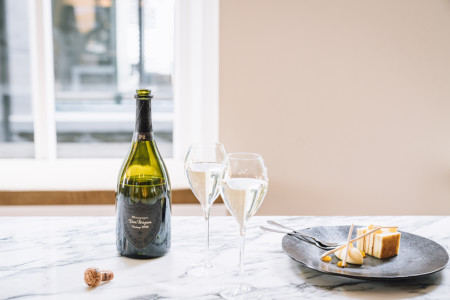Champagne
A very long time ago the North of France housed an inner sea. Evidence of this sea and its seabed can be found in the soil of most of this area, where remains of shellfish and fossils are easily tracked. A high concentration of chalk is the result and forms the character of the region we now call Champagne. Champagne wines are considered the ultimate in the world of sparkling wines.
The best wines from Champagne
A very long time ago the North of France housed an inner sea. Evidence of this sea and its seabed can be found in the soil of most of this area, where remains of shellfish and fossils are easily tracked. A high concentration of chalk is the result and forms the character of the region we now call Champagne. Because of the chalk, the soil is very permeable to water, so rainwater is easily dissipated and warmth of the sun during the day is released at night. A calcareous subsoil (often chalk-based), absorbs heat and facilitates vine drainage, promoting the balance of the grapes and creating vast underground caves, perfect for ripening wines.
Champagne, however, is not Burgundy. Its climate is not as tolerant, nor is its soil as diverse. Campagne’s chalky soils and unique climate create the perfect conditions for crafting its renowned sparkling wine. Champagne's excellence is determined by the combination of grape excellence and winemaker expertise.
Champagne is a white wine. However, the wines if made from mostly blue grapes: pinot noir en pinot meunier. Chardonnay is also used. A Champagne made from 100% Chardonnay grapes is called Blanc de Blancs, a Champagne made from 100% blue grapes is called Blanc de Noirs. The latter is quite rare.
Some of the best Champagnes come from domaines like Selosse, Krug, Bollinger, Veuve Clicquot, Armand de Brignac, Salon, Roederer, Moet et Chandon.
Where exactly is the Champagne region?
You only have to travel 150 kilometers northeast of Paris to find yourself in the heart of Champagne! What makes it special is that the 34,200-hectare wine-growing region is located exactly between the 48th and 49th parallels. This is just where wine growing is still possible. Most of the vineyards are spread out along the Marne River and its rolling hills. But the Aube and Seine rivers are also important for winegrowing here. Three towns in Champagne are particularly well known: Reims, Épernay, and Aÿ. While Reims is home to the great champagne houses and attracts the most tourists every year, Épernay and Aÿ are considered the major winegrowing centers of the region. If you take a closer look at Champagne, you will notice that it is divided into five different sub-regions.
The best known is undoubtedly the Montagne de Reims, which stretches around the city of the same name. The sub-region is best known for its powerful and well-structured Pinot Noir. Directly opposite, to the west, the Vallée de la Marne stretches along the river of the same name. Here, Meunier is the most widely grown grape, producing fresh and fruity base wines. Acting as a hub between the Montagne de Reims and the Vallée de la Marne, the Côte des Blancs winds its way south from Épernay. Chardonnay is the trump card here. The grape produces elegant and very long-lasting champagnes. Further south, the Côte de Sézanne is located somewhat separately. It is quite similar to the Côte des Blancs, although the soils differ slightly. And in the very south of Champagne, the Côte des Bar is located somewhat apart. It was the last subregion to be added at the beginning of the 20th century. Here, Pinot Noir is the big star.

Climate and soils in Champagne
Because Champagne is the northernmost wine-growing region in France, it is also the coolest. It has a consistently continental climate with very cold winters and warm summers. Late frosts at the end of April or beginning of May are not uncommon, even in the southern sub-regions. In addition, many years can also be very rainy. So viticulture here is anything but easy. And yet the winegrowers do not give up. The reason for this can be found in the soils. These are very old – and very chalky.
In some places, you can even see the chalk with the naked eye because it lies in chunks between the vines! It is precisely this chalk that gives the wines their enchanting minerality. In some areas, limestone is also present, which adds an extra touch of elegance. Clay and sand can also be found in the soil. When a champagne has more volume and body, the vines that produce the grapes for these sparkling wines are mainly found on such soils.
Grapes in wines from Champagne
Champagne is best known for its two red grape varieties, Pinot Noir and Meunier, and Chardonnay on the white grape side. 38 per cent of the vineyards are planted with Pinot Noir – Meunier and Chardonnay each account for 30 per cent. That leaves exactly one per cent. And this is shared by five other grape varieties that are also permitted but rarely used. These are Pinot Blanc, Pinot Gris, Arbane, Petit Meslier and Vidal Blanc. Incidentally, Vidal Blanc is a fungus-resistant grape variety, a so-called Piwi. It has only been allowed to be grown in Champagne for a few years.
The distribution of vineyards already clearly shows that most sparkling wines in Champagne are made from Pinot Noir, Chardonnay and Meunier. As a rule, they are not used in pure form for a champagne either, but are blended. This way, each grape can contribute its own unique characteristics to the cuvée. This is precisely one of the reasons why champagnes taste so different. Let's take a closer look.
What does a sparkling wine from Champagne taste like?
At this point, we need to go into a little more detail. The explanation for the different characters and diverse tastes of champagne goes far deeper than the selection of grapes from different sub-regions. The best way to get an overview is to look at the different styles of champagne, for which there are very precise guidelines. And that's exactly what we're going to do in the following chapters.
The different types of Champagne
Champagne is made in a number of different styles or type. These are:
- Non Vintage Champage
- Millesime Champagne
- Prestige Cuvee
- Blanc de Blancs
- Blanc de Noirs
- Rose Champagne
These different styles or types are explained in the next chapters.
Non-vintage champagne
A so-called non-vintage champagne is the basic champagne of every house or winemaker. Here, the cellar master blends not only different grape varieties, but also several vintages. And for good reason. Because the weather in Champagne is always unpredictable, each vintage tastes different. However, a non-vintage champagne should taste the same every year. After all, it is something like the maison's calling card in terms of taste. This is precisely why several vintages are artfully blended together here, so that the result always tastes the same. These champagnes are usually charming palate pleasers and the ideal introduction to familiarize yourself with the style of a maison.

Millésimé champagne
In stark contrast to non-vintage champagne is vintage champagne, also known as millésimé. This sparkling wine is intended to reflect the differences between vintages. For this reason, cellar masters only use grapes from a single vintage. In addition, the yeast must be left to ferment in the bottle for much longer than with non-vintage champagne.
For non-vintage champagne, a minimum of 15 months is required, while for millésimé champagne, a minimum of 36 months is required. However, many houses significantly exceed this minimum. A vintage champagne is therefore always more complex and full of character than a non-vintage champagne. Furthermore, it may only be produced in the best years. Which vintages qualify is decided exclusively by the Champagne Committee after the harvest.
Prestige Cuvée
This is the flagship of each house. There are no binding specifications for a prestige champagne. That is why the designation is usually not on the label. However, the cellar master uses only the best grapes from the best vineyards and the best vintages. Accordingly, prestige champagnes are more expensive than millésimés, but they also enchant with their enormous depth and radiance. Anyone who has ever had such a champagne in a glass will not forget it in a hurry.
Blanc de Blancs
Translated, Blanc de Blancs means ‘white from white grapes’. The name says it all, because only white grape varieties are used here. Usually this is then Chardonnay. As a rule, the cellar master wants to bring the character of a particular terroir or municipality to the bottle with a Blanc de Blancs. These champagnes are usually full of elegance and freshness and have a very good structure. They can also age extremely well.

Blanc de Noirs
Here we have the ‘white made from black grapes’. Pinot Noir or Meunier are pressed white here. If the grapes are pressed particularly slowly, the sparkling wine can have a very light pink tinge. This is usually an indication that the sparkling wine is very fruity and caresses the palate. But at the same time, these wines are surprisingly elegant.
Rosé Champagne
To prepare a rosé champagne, the cellar master has several options. The most common is the so-called rosé d'assemblage, in which a dash of red wine is added to the expedition dosage after disgorging. These champagnes are very fruity and delicate. To make a rosé de saignée, the cellar master macerates red grapes until he has achieved the desired colour. These rosé champagnes are much stronger and more intense and have a very complex structure.
Champagne producers

What food goes with sparkling wines from the Champagne region?
It would be a shame to reduce champagne to an aperitif. Yes, its fine bubbles perfectly prepare the palate for further delights. And yes, its moderate alcohol content, which hardly ever exceeds 12.5 percent by volume, makes it an ideal introduction. Especially if you serve a non-vintage. But champagne is also an excellent accompaniment to food!
A Blanc de Blancs, for example, goes very well with sushi, sole or scallops, while a Blanc de Noirs is the ideal accompaniment to all kinds of poultry dishes. It is also a great match for veal. A Millésimé, on the other hand, is a guaranteed delight with duck or goose. And yes, it also goes very well with a spicy pizza or savoury crisps. And with vintage sardines! We are very happy to serve caviar or oysters with a prestige champagne. And a rosé champagne is an ideal accompaniment to fish and shell soups. Particularly strong varieties even go well with a steak! As you can see, there are no limits to your creativity. Discover the different champagnes at Best of Wines now!


